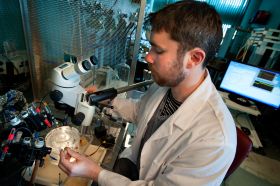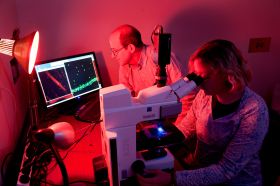
Co-Director, Brain Research NZ - Ranghau Roro Aotearoa
Email cliff.abraham@otago.ac.nzTel 64 3 479 7648
Visit Professor Abraham's profile
Research summary
I have a long-standing research interest in the rules and mechanisms governing synaptic plasticity, metaplasticity and memory formation in the brain, with a particular focus on cellular and molecular events in the hippocampus. My lab has expertise in electrophysiological, behavioural and immunofluorescent microscopy approaches to studying the mechanisms mediating the induction and persistence of synaptic plasticity in vivo and in vitro, and their relevance to memory.
My interests extend to clinical research areas such as Alzheimer's disease, schizophrenia, neurogenesis and neuroprotection, using animal models. My research is highly collaborative, with partners based locally, nationally and internationally. A major current research interest is in biomarkers and therapeutic molecules for Alzheimer's disease.
Brain Health Research Centre website
Cellular and Molecular Mechanisms of Synaptic Plasticity
 One of the most likely neural mechanisms mediating memory storage is long-lasting plasticity in the strength of synaptic transmission between connected neurons. This plasticity includes both long-term potentiation (LTP) and long-term depression (LTD) of synaptic efficacy. In my research programme, funded by the New Zealand Health Research and Marsden Councils, the cellular and molecular mechanisms of LTP and LTD are studied in the hippocampus, a brain structure important for certain kinds of learning and memory.
One of the most likely neural mechanisms mediating memory storage is long-lasting plasticity in the strength of synaptic transmission between connected neurons. This plasticity includes both long-term potentiation (LTP) and long-term depression (LTD) of synaptic efficacy. In my research programme, funded by the New Zealand Health Research and Marsden Councils, the cellular and molecular mechanisms of LTP and LTD are studied in the hippocampus, a brain structure important for certain kinds of learning and memory.
Our studies on the molecular mechanisms of such synaptic plasticity (done in collaboration with Professor Warren Tate, Biochemistry and Dr Joanna Williams, Anatomy and Structural Biology) have focused on the role that gene expression plays in the maintenance of LTP and LTD across time. Related experiments are aimed at identifying the changes in synaptic proteins, including glutamate receptors, that accompany LTP and LTD.
Mechanisms for Establishing LTP and LTD
The mechanisms for establishing LTP and LTD, including understanding the conditions under which they can be elicited, is another major research interest. We are interested in how the induction processes are controlled by intracellular calcium levels, stress hormones, aging, and neurotransmitters mediating arousal and attention. A major focus of interest is the mechanisms by which prior neural activity controls the subsequent induction of synaptic plasticity, a novel set of phenomena we have termed “metaplasticity”.
Synaptic Mechanisms and Neurological Disease
 A further interest lies in the mechanisms of plasticity disruption in neurological disorders characterized by memory deficits, such as Alzheimer's disease and schizophrenia. I am Director of an HRC programme grant aimed at identifying predictive biomarkers of, and therapeutic molecules for, Alzheimer's disease. The latter work focuses on secreted amyloid precursor protein-alpha and agmatine. My lab is also involved in a joint project with Professor David Bilkey investigating the synaptic mechanisms that may account for behavioural deficits in a model of schizophrenia.
A further interest lies in the mechanisms of plasticity disruption in neurological disorders characterized by memory deficits, such as Alzheimer's disease and schizophrenia. I am Director of an HRC programme grant aimed at identifying predictive biomarkers of, and therapeutic molecules for, Alzheimer's disease. The latter work focuses on secreted amyloid precursor protein-alpha and agmatine. My lab is also involved in a joint project with Professor David Bilkey investigating the synaptic mechanisms that may account for behavioural deficits in a model of schizophrenia.
Publications
Mockett, B.G., Guévremont, D., Wutte, M., Hulme, S.R., Williams, J.M., & Abraham, W.C. (2011). Calcium/calmodulin-dependent protein kinase II mediates group I metabotropic glutamate receptor-dependent protein synthesis and long-term depression in rat hippocampus. Journal of Neuroscience. 31, 7380-7391.
Tenorio, G., Connor, S.A., Guevremont, D., Abraham, W.C., Williams, J., O'Dell, T.J., & Nguyen, P.V. (2010). “Silent” priming of translation-dependent LTP by beta-adrenergic receptors involves phosphorylation and recruitment of AMPA receptors. Learning and Memory, 17, 645-653.
Ireland, D.R. & Abraham, W.C. (2009). Mechanisms of Group I mGluR-dependent depression of NMDA receptor-mediated transmission at Schaffer collateral-CA1 synapses. Journal of Neurophysiology, 101, 1375-1385.
Abraham, W.C. (2008). Metaplasticity – tuning synapses and networks for plasticity. Nature Reviews Neuroscience, 9, 387-399.
Taylor, C.J., Ireland, D.R., Ballagh, I., Bourne, K., Marechal, N.M., Turner, P.R., Bilkey, D.K., Tate, W.P., Abraham, W.C. (2008). Endogenous secreted amyloid precursor protein-α regulates hippocampal NMDA receptor function, long-term potentiation and spatial memory. Neurobiology of Disease, 31, 250-260.
Williams, J.M., Guévremont, D., Mason-Parker, S.E., Luxmanan, C., Tate, W.P., Abraham, W.C. (2007). Differential trafficking of AMPA and NMDA receptors during LTP in awake adult animals. Journal of Neuroscience, 27, 14171-14178.
Abraham, W.C., Mason-Parker, S.E., Irvine, G.I., Logan, B., & Gill, A.I. (2006). Induction and activity-dependent reversal of persistent LTP and LTD in lateral perforant path synapses in vivo. Neurobiology of Learning and Memory, 86, 82-90.
Abraham, W.C., Robins, A. (2005). Memory retention – the synaptic stability versus plasticity dilemma. Trends in Neurosciences, 28, 73-78.
